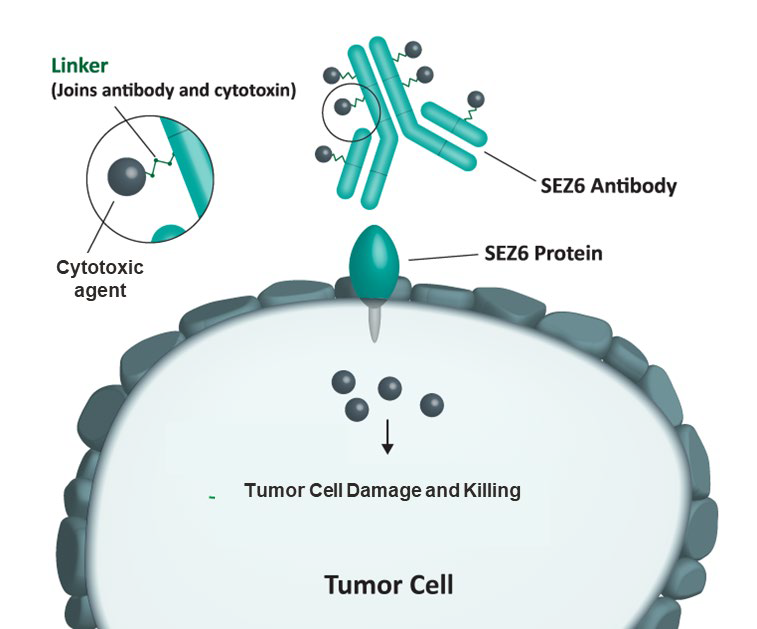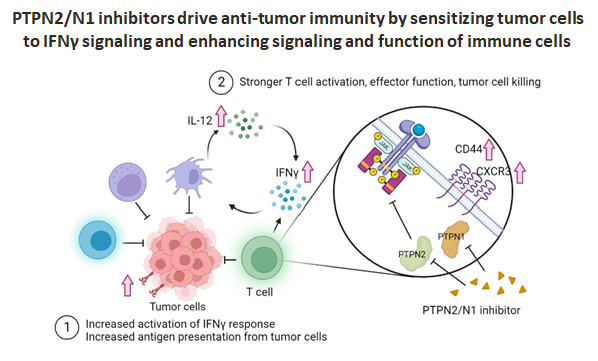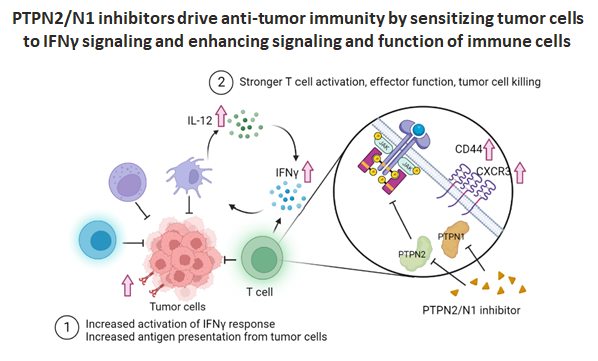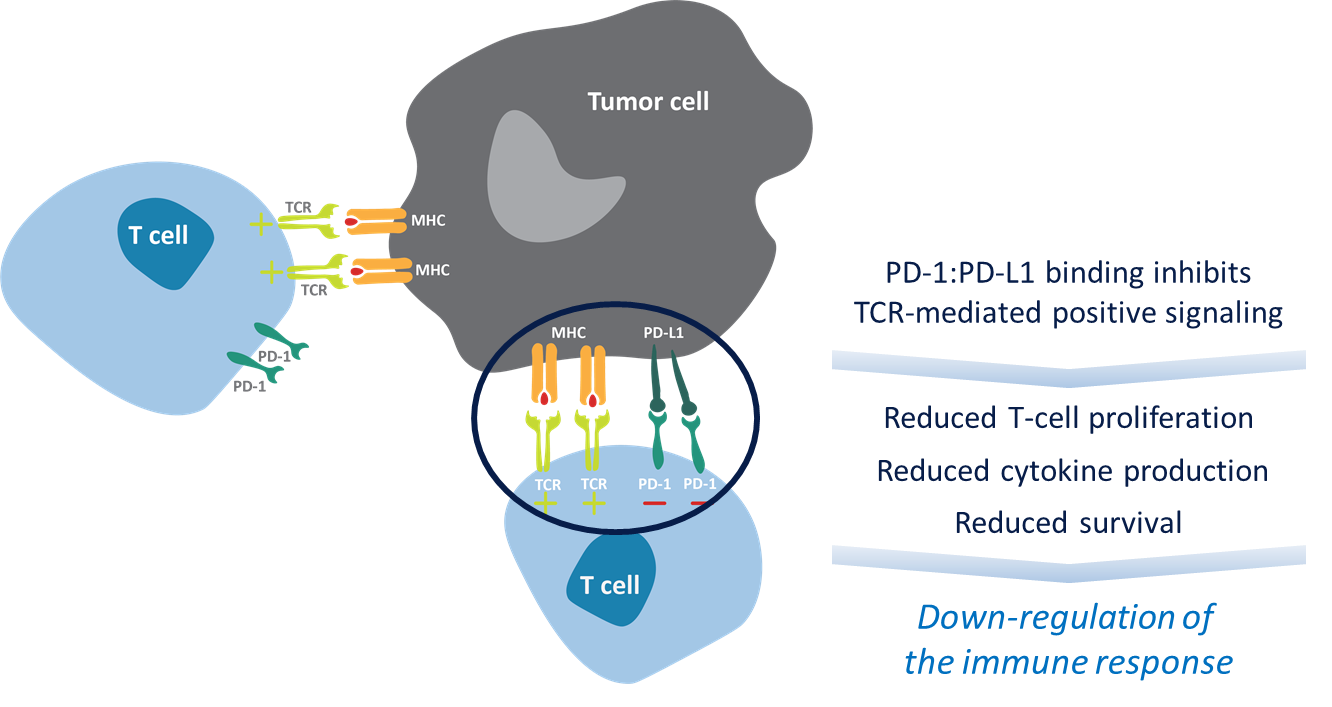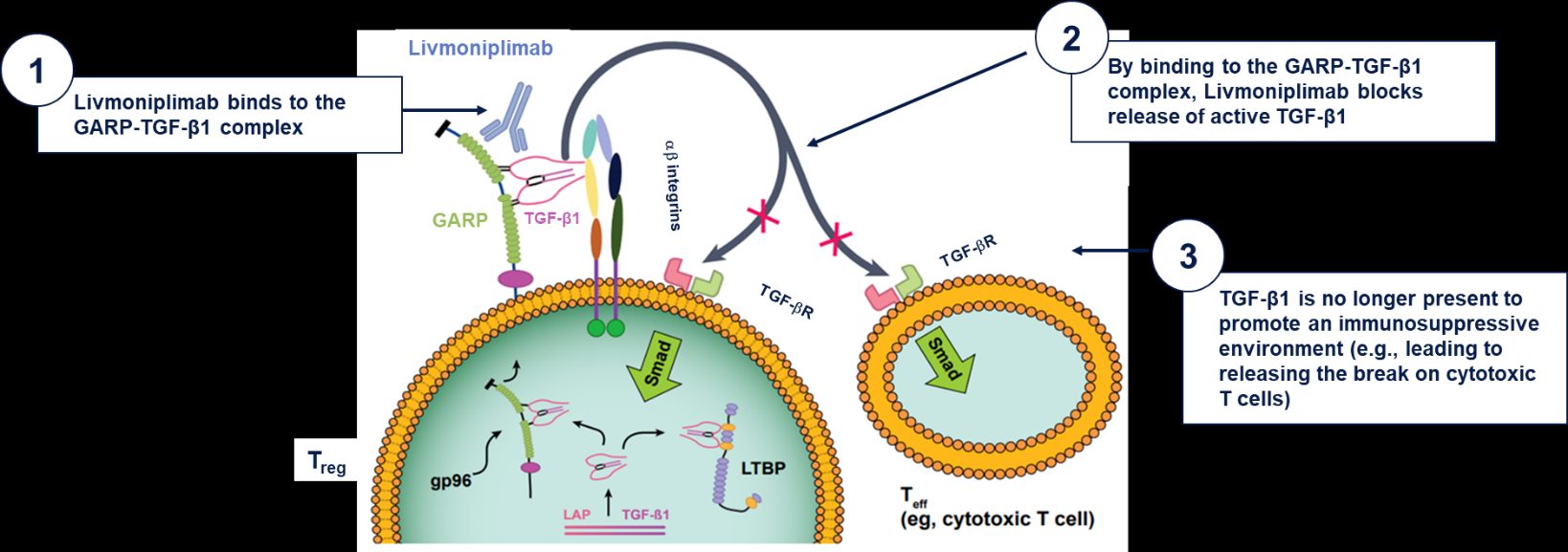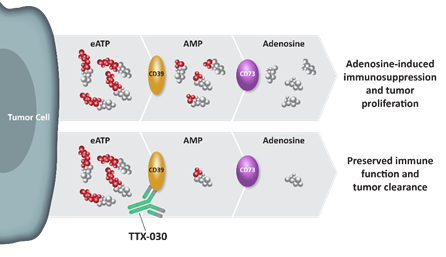PIPELINE
OVERVIEW
ABBV-400 is an investigational drug under clinical development. Safety and efficacy have not been established.
ABBV-400 is a c-Met targeting antibody-drug conjugate (ADC) employing a topoisomerase inhibitor that is being investigated in colorectal cancer (CRC), non-small cell lung cancer (NSCLC), and gastroesophageal adenocarcinoma (GEA).
PROPOSED MECHANISM OF ACTION
The protein, mesenchymal-epithelial transition factor (c-Met), which is also known as MET protein, AUTS9, RCCP2, DFNB97 and hepatocyte growth factor receptor (HGFR), is essential for survival and function of normal cells.1
In numerous cancers, the MET gene, which encodes the protein c-Met, is either amplified or mutated to constantly activate its downstream signaling pathways to sustain rapid proliferation and survival of cancer cells. In NSCLC, both c-Met and HGF are over-expressed relative to the adjacent normal lung tissues.1
c-Met antibody drug conjugates bind c-Met receptors, which are internalized and cytotoxins attached to the antibody via linkers are released into the cytosol where they seek to damage cancerous cells.
ABBV-400 uses c-Met to deliver a topoisomerase inhibitor to overexpressing tumor cells inhibiting DNA replication thus stopping cell proliferation and inducing cytotoxicity.
DEVELOPMENT
ABBV-400 is being investigated to treat colorectal cancer (CRC), non-small cell lung cancer (NSCLC), and gastroesophageal adenocarcinoma (GEA).
CLINICAL TRIALS
View select clinical trials with ABBV-400 now. To view a full list of clinical trials in which ABBV-400 is being investigated, please visit ClinicalTrials.gov.
- Park KC, Richardson DR. The c-MET oncoprotein: Function, mechanisms of degradation and its targeting by novel anti-cancer agents. Biochimica et Biophysica Acta (BBA)-General Subjects. 2020 Oct 1;1864(10):129650.
OVERVIEW
ABBV-514 is an investigational drug under clinical development. Safety and efficacy have not been established.
ABBV-514 is an anti-chemokine C-C motif receptor 8 (CCR8) antibody that is being investigated for the treatment of relapsed non-small cell lung cancer (NSCLC) and head and neck squamous cell carcinoma (HNSCC) as a single agent and in combination with a PD-1 inhibitor.
PROPOSED MECHANISM OF ACTION
CCR8 is a chemokine receptor that mediates chemotaxis and cell/cell interactions in the context of T-helper type 2 cell responses and T-cell trafficking to the skin. Within tumors, regulatory T-cells (Tregs) are a key immunosuppressive cell population known to prevent antitumor immune responses and high intratumoral Treg levels have been associated with negative outcomes in several cancers.1-3 CCR8 is overexpressed in Tregs found in the TME and is upregulated in tumor tissues, including HNSCC, NSCLC, and colorectal cancer (CRC).4-6 CCR8 is highly expressed in tumor-infiltrating Tregs and correlates with poor prognosis in both NSCLC and CRC patients.5
DEVELOPMENT
ABBV-514 is being investigated in a Phase 1 trial for the treatment of relapsed NSCLC and HNSCC.
CLINICAL TRIALS
View select clinical trials with ABBV-514 now. To view a full list of clinical trials in which ABBV-514 is being investigated, please visit ClinicalTrials.gov.
References
- Shang B, Liu Y, Jiang SJ, et al. Prognostic value of tumor-infiltrating FoxP3+ regulatory T cells in cancers: a systematic review and meta-analysis. Sci Rep. 2015;5:15179.
- Fridman WH, Zitvogel L, Sautes-Fridman C, et al. The immune contexture in cancer prognosis and treatment. Nat Rev Clin Oncol. 2017;14(12):717-34.
- Bruni D, Angell HK, Galon J. The immune contexture and Immunoscore in cancer prognosis and therapeutic efficacy. Nat Rev Cancer. 2020;20(11):662-80.
- Meng L, et al. CCR4, CCR8, and P2RY14 as Prognostic Factors in Head and Neck Squamous Cell Carcinoma Are Involved in the Remodeling of the Tumor Microenvironment. Front Oncol. 2021; 11: 618187.
- De Simone M, et al. Transcriptional Landscape of Human Tissue Lymphocytes Unveils Uniqueness of Tumor-Infiltrating T Regulatory Cells. Immunity. 2016;45:1135-1147.
- Plitas G, Konopacki C, Wu K, et al. Regulatory T Cells Exhibit Distinct Features in Human Breast Cancer. Immunity. 2016;45(5):1122-34.
OVERVIEW
ABBV-706 is an investigational drug under clinical development. Safety and efficacy have not been established.
ABBV-706 is a SEZ6-targeted antibody-drug conjugate (ADC) being investigated in advanced solid tumors.
PROPOSED MECHANISM OF ACTION
Seizure-related homolog 6 (SEZ6) is a transmembrane protein found on the cell surface of select neuronal lineage cells.1,2
SEZ6 is selectively expressed on neuroendocrine tumors, including small-cell lung cancer (SCLC), central nervous system (CNS) tumors, and high-grade neuroendocrine carcinomas (NECs), with minimal normal cell expression.3 SEZ6 was chosen as a target for the development of novel ADCs carrying payloads designed to kill neuroendocrine tumor cells.4 ABBV-706 targets tumor cells expressing SEZ6, is rapidly internalized, and delivers a tumor-cell killing proprietary payload.
DEVELOPMENT
ABBV-706 is being investigated in a Phase 1 trial for the treatment of advanced solid tumors.
CLINICAL TRIALS
View select clinical trials with ABBV-706 now. To view a full list of clinical trials in which ABBV-706 is being investigated, please visit ClinicalTrials.gov.
- Shimizu-Nishikawa K, et al. Cloning and characterization of seizure-related gene, SEZ-6. Biochem Biophys Res Commun. 1995;216(1):382-9.
- Gunnersen JM, et al. Sez-6 proteins affect dendritic arborization patterns and excitability of cortical pyramidal neurons. Neuron. 2007;56(4):621-39.
- Kudoh S, et al. Significance of achaete-scute complex homologue 1 (ASCL1) in pulmonary neuroendocrine carcinomas; RNA sequence analyses using small cell lung cancer cells and Ascl1-induced pulmonary neuroendocrine carcinoma cells. Histochem Cell Biol. 2020;153(6):443-456.
- Wiedemeyer WR et al. ABBV-011, A Novel, Calicheamicin-Based Antibody–Drug Conjugate, Targets SEZ6 to Eradicate Small Cell Lung Cancer Tumors. Mol Cancer Ther. 2022;21:986-98.
OVERVIEW
ABBV[CC1] -CLS-484 is an unapproved investigational drug under clinical development. Safety and efficacy have not been established.
ABBV-CLS-484 is a PTPN2/N1 small molecule inhibitor (SMI).
PROPOSED MECHANISM OF ACTION1-4
ABBV-CLS-484 is a small molecule that binds to ubiquitously expressed protein tyrosine phosphatase non-receptor type 2 (PTPN2) and type 1 (PTPN1). Importantly, PTPN2/N1 inhibition drives both tumor cell dependent and immune cell dependent anti-cancer mechanisms of action. PTPN2/N1 inhibition in tumor cells blocks IFN signaling through the Janus kinase/signal transducers and activators of transcription (JAK/STAT) pathway resulting in growth delay, increased tumor antigen presentation, and elevated pro-inflammatory chemokine release. Additionally, PTPN2/N1 inhibition promotes the activation and proinflammatory anti-tumorigenic function of multiple immune cell subsets. In T cells, PTPN2 acts as a negative regulator of T-cell receptor(TCR) signaling whereby inhibition of these enzymes results in T cell activation, proliferation and immune effector functions, including tumoricidal action.
DEVELOPMENT
ABBV-CLS-484 is being investigated in a phase 1 study as a monotherapy and in combination with a PD-1 inhibitor for the treatment of patients with metastatic or locally advanced solid tumor cancer.
ABBV-CLS-484 is co-developed by Calico and AbbVie
CLINICAL TRIALS
View select clinical trials with ABBV-CLS-484 now. To view a full list of clinical trials in which ABBV-CLS-484 is being investigated, please visit ClinicalTrials.gov.
- Heinonen KM, et al. T-cell protein tyrosine phosphatase deletion results in progressive systemic inflammatory disease. Blood. 2004;103(9):3457-3464.
- Wiede, F. et al. T cell protein tyrosine phosphatase attenuates T cell signaling to maintain tolerance in mice. J Clin Invest. 2011;121:4758-4774.
- Hering L, et al. Protein Tyrosine Phosphatase Non-Receptor Type 2 Function in Dendritic Cells Is Crucial to Maintain Tissue Tolerance. Frontiers in Immunology. 2020;11:1856.
- Manguso RT, et al. In vivo CRISPR screening identifies Ptpn2 as a cancer immunotherapy target. Nature. 2017;547(7664):413-418.
OVERVIEW
ABBV-CLS-579 is an unapproved investigational drug under clinical development. Safety and efficacy have not been established.
ABBV-CLS-579 is a PTPN2/N1 small molecule inhibitor (SMI).
PROPOSED MECHANISM OF ACTION1-3
ABBV-CLS-579 is a small molecule that binds to ubiquitously expressed protein tyrosine phosphatase non-receptor type 2 (PTPN2) and type 1 (PTPN1). Importantly, PTPN2/N1 inhibition drives both tumor cell dependent and immune cell dependent anti-cancer mechanisms of action. PTPN2/N1 inhibition in tumor cells promotes IFN signaling through the Janus kinase/signal transducers and activators of transcription (JAK/STAT) pathway resulting in growth delay, increased tumor antigen presentation, and elevated pro-inflammatory chemokine release. Additionally, PTPN2/N1 inhibition promotes the activation and proinflammatory anti-tumorigenic function of multiple immune cell subsets. In T cells, PTPN2 acts as a negative regulator of T-cell receptor (TCR) signaling whereby inhibition of these enzymes results in T cell activation, proliferation and immune effector functions, including tumoricidal action.
DEVELOPMENT
ABBV-CLS-579 is being investigated in a phase 1 study as a monotherapy and in combination with a PD-1 inhibitor for the treatment of patients with metastatic or locally advanced solid tumor cancer.
ABBV-CLS-579 is co-developed by Calico and AbbVie
CLINICAL TRIALS
View select clinical trials with ABBV-CLS-579 now. To view a full list of clinical trials in which ABBV-CLS-579 is being investigated, please visit ClinicalTrials.gov.
- Heinonen KM, et al. T-cell protein tyrosine phosphatase deletion results in progressive systemic inflammatory disease. Blood. 2004;103(9):3457-3464.
- Wiede, F. et al. T cell protein tyrosine phosphatase attenuates T cell signaling to maintain tolerance in mice. J Clin Invest. 2011;121:4758-4774.
- Hering L, et al. Protein Tyrosine Phosphatase Non-Receptor Type 2 Function in Dendritic Cells Is Crucial to Maintain Tissue Tolerance. Frontiers in Immunology. 2020;11:1856.
- Manguso RT, et al. In vivo CRISPR screening identifies Ptpn2 as a cancer immunotherapy target. Nature. 2017;547(7664):413-418.
OVERVIEW
Budigalimab is an investigational drug under clinical development. Safety and efficacy have not been established.
Budigalimab is a humanized, recombinant, IgG1 monoclonal antibody targeting PD-1, incorporating an Fc mutation to limit FcγR-mediated effector function.
PROPOSED MECHANISM OF ACTION
Programmed cell death-1 (PD-1)/programmed cell death ligand-1 (PD-L1) interactions are part of an immune system checkpoint pathway that prevents T cells from causing damage to healthy cells. Tumor cells often overexpress PD-L1 to take advantage of this checkpoint and prevent an antitumor immune response.1,2
Budigalimab blocks the interaction between PD-1 and its ligands, PD-L1 and PD-L2, by binding to PD1. This prevents the inhibitory signaling pathway from being triggered when T cells encounter the tumor and restores the immune system's ability to recognize tumor cells as abnormal, allowing T cells to target these tumor cells for death.3-6
DEVELOPMENT
Budigalimab is being investigated in phase 1 and 2 trials for the treatment of advanced solid tumors in combination with other agents.
CLINICAL TRIALS
View select clinical trials with budigalimab now. To view a full list of clinical trials in which budigalimab is being investigated, please visit ClinicalTrials.gov.
- Ohaegbulam KC, Assal A, Lazar-Molnar E, Yao Y, Zang X. Human cancer immunotherapy with antibodies to the PD-1 and PD-L1 pathway. Trends Mol Med. 2015;21(1):24-33.
- Freeman GJ, Long AJ, Iwai Y, et al. Engagement of the PD-1 immunoinhibitory receptor by a novel B7 family member leads to negative regulation of lymphocyte activation. J Exp Med. 2000;192(7):1027-1034.
- Powderly et al. Model Informed Dosing Regimen and Phase I Results of the Anti-PD-1 Antibody Budigalimab (ABBV-181). Clin Transl Sci. 2021;14:277–287.
- Italiano A, et al. First-in-human phase 1 study of budigalimab, an anti-PD-1 inhibitor, in patients with nonsmall cell lung cancer and head and neck squamous cell carcinoma. Cancer Immunol Immunother. 2021 Jul 3. doi: 10.1007/s00262-021-02973-w. Online ahead of print.
- Calvo E, et al. Safety, pharmacokinetics, and efficacy of budigalimab with rovalpituzumab tesirine in patients with small cell lung cancer. Cancer Treat Res Commun. 2021;28:100405.
OVERVIEW
Livmoniplimab is an investigational drug under clinical development. Safety and efficacy have not been established.
Livmoniplimab (ABBV-151) is a potential first-in-class humanized monoclonal antibody that is designed to bind to the GARP-TGF-β1 complex and is being investigated for the treatment of solid tumors.
PROPOSED MECHANISM OF ACTION
Livmoniplimab binds the GARP-TGF-β1 complex on the surface of Tregs. Upon binding to the GARP-TGF-β1 complex, livmoniplimab inhibits the release of active TGF-β1. The inhibition of TGF-β1 signaling may enhance the responsiveness to anti-PD1 therapy by helping restore effector CD8+ T-cell activation, expansion, and infiltration within tumor.1,2,3
(Adapted from Metelli A, et al. Journal of Hematology & Oncology (2018) 11:24. http://creativecommons.org/licenses/by/4.0/ for CC BY 4.0)
DEVELOPMENT
Livmoniplimab is being investigated in a phase 1 study for the treatment of patients with advanced solid tumors.
Livmoniplimab and budigalimab (PD-1 inhibitor) are in clinical development to evaluate the inhibition of signaling pathways known to drive tumor growth and progression.
CLINICAL TRIALS
View select clinical trials with ABBV-151 now. To view a full list of clinical trials in which ABBV-151 is being investigated, please visit ClinicalTrials.gov.
- Metelli A, et al. Immunoregulatory functions and the therapeutic implications of GARP-TGF-β in inflammation and cancer. J Hematol Oncol 2018; 11:24.
- Metelli A, et al . Surface Expression of TGFβ Docking Receptor GARP Promotes Oncogenesis and Immune Tolerance in Breast Cancer. Cancer Res 2016; 76:7106–7117.
- Cuende J, et al. Monoclonal antibodies against GARP/TGF-β1 complexes inhibit the immunosuppressive activity of human regulatory T cells in vivo. Sci Transl Med. 2015;7(284):284ra56.
OVERVIEW
Telisotuzumab vedotin (Teliso-V; ABBV-399) is an investigational drug under clinical development. Safety and efficacy have not been established.
Telisotuzumab vedotin (Teliso-V; ABBV-399) is a c-Met-targeted antibody-drug conjugate (ADC) comprised of the ABT-700 (c-Met-targeting) antibody conjugated to the cytotoxic microtubule inhibitor monomethylauristatin E (MMAE) via a cleavable valine–citrulline (vc) linker.
PROPOSED MECHANISM OF ACTION
The c-Met receptor tyrosine kinase is the cell surface receptor for hepatocyte growth factor (HGF) encoded by the MET protooncogene. MET is aberrantly activated in cancers contributing to tumor progression, angiogenesis, invasiveness, metastasis, and resistance and is overexpressed in non-small cell lung cancer (NSCLC; 40%) and several other solid tumor types.1 Overexpression of c-Met has been reported in Teliso-V NSCLC studies at rates of 25–39% across nonsquamous (NSQ) and squamous (SQ) histologies,3,4 with some other studies reporting ranges of 15–70%.5
c-Met inhibitors require MET amplification and/or c-Met activation for activity; however, as demonstrated in preclinical models, Teliso-V, a c-Met targeted ADC, uses c-Met to deliver a cytotoxin to c-Met-overexpressing tumor cells enabling cell killing regardless of reliance on MET signaling.1 Although, MET amplification is a therapeutically actionable target, it generally occurs in 1% to 5% of de novo cancers, whereas c-Met overexpression is more common, occurring in up to 50% of many advanced solid tumors.2
The use of an ADC that targets c-Met–positive tumors represents a therapeutic strategy with which to induce tumor cell killing independently of MET signaling pathway inhibition because it involves the delivery of the potent cytotoxin MMAE directly to c-Met–positive tumor cells.2
Although a c-Met–targeting ADC may present the risk of on target toxicity based on c-Met normal tissue expression, preclinical and early phase results have demonstrated a strong correlation between Teliso-V anti-tumor activity and c-Met expression levels as c-Met expression is significantly higher in many cancers compared with normal tissue.1
DEVELOPMENT
Teliso-V is in phase 3 development in patients with previously treated c-Met+(by protein overexpression detected by IHC) non-small cell lung cancer (NSCLC).
Teliso-V is licensed from Seagen and Pierre Fabre
CLINICAL TRIALS
View select clinical trials with Teliso-V now. To view a full list of clinical trials in which Teliso-V is being investigated, please visit ClinicalTrials.gov.
- Wang J, Anderson MG, Oleksijew A, et al. ABBV-399, a c-Met antibody-drug conjugate that targets both MET-amplified and c-Met-overexpressing tumors, irrespective of MET pathway dependence. Clin Cancer Res. 2017 Feb 15;23(4):992-1000.
- Strickler JH, et al. First-in-Human Phase I, Dose-Escalation and -Expansion Study of Telisotuzumab Vedotin, an Antibody–Drug Conjugate Targeting c-Met, in Patients With Advanced Solid Tumors. Journal of Clinical Oncology . 2018;36(33):3298-3306.
- Motwani M, Panchabhai S, Bar J, et al. Prevalence of c-Met overexpression (c-Met+) and impact of prior lines of treatment on c-Met protein expression in NSCLC. World Conference on Lung Cancer (WCLC); 2021.
- Ansell PJ, Baijal S, Liede A, et al. Prevalence and characterization of c-MET–overexpressing non-small cell lung cancer (NSCLC) across clinical trial samples and real-world patient cohorts from the City of Hope National Medical Center. Cancer Research UK (CRUK) - Lung Cancer Conference. Manchester, UK; 2022.
- Liang H, Wang M. MET oncogene in non-small cell lung cancer: Mechanism of MET dysregulation and agents targeting the HGF/c-Met axis. Onco Targets Ther 2020; 13: 2491-2510.
OVERVIEW
TTX-030 is an investigational drug under clinical development. Safety and efficacy have not been established.
TTX-030 is an anti-CD39 monoclonal antibody that is being investigated in solid tumors.
PROPOSED MECHANISM OF ACTION1,2
In solid tumors, ATP is abundantly released in the extracellular space, leading to an accumulation of extracellular ATP (eATP) levels far in excess of those found in healthy tissues. Extracellular ATP acts as a proinflammatory stimulus by agonizing P2 purinergic receptors in immune cells.
Tumors are proficient at scavenging eATP, converting it to immunosuppressive adenosine by means of two ectonucleotidases, CD39 and CD73. CD39 hydrolyzes ATP converting it to adenosine monophosphate (AMP), which can in turn be converted to adenosine by CD73. Adenosine acts on P1 receptors found ubiquitously on immune cells, causing immunosuppression, and therefore has anti-inflammatory effects.
TTX-030 inhibits CD39 enzymatic activity, thus preventing hydrolysis of proinflammatory ATP to immunosupressive adenosine resulting in a preservation of immune cell function and tumor clearance.
DEVELOPMENT
TTX-030 is being investigated as a monotherapy and in combination with a PD1 inhibitor or chemotherapy in patients with solid tumors.
*Developed by Trishula Therapeutics through Phase 1b and AbbVie has option to lead global development.
CLINICAL TRIALS
View select clinical trials with TTX-030 now. To view a full list of clinical trials in which TTX-030 is being investigated, please visit ClinicalTrials.gov.
- Pellegatti P, Raffaghello L, Bianchi G, Piccardi F, Pistoia V, Di Virgilio F. Increased level of extracellular ATP at tumor sites: in vivo imaging with plasma membrane luciferase. PLoS One 2008;3:e2599.
- Takenaka MC, Robson S, Quintana FJ. Regulation of the T cell response by CD39. Trends Immunol 2016;37:427-39.










